Aha! Review: The Ultimate Product Roadmap Solution
 Aha! Review: The Ultimate Product Roadmap Solution
Aha! Review: The Ultimate Product Roadmap Solution
Aha! Review: The Ultimate Product Roadmap Solution
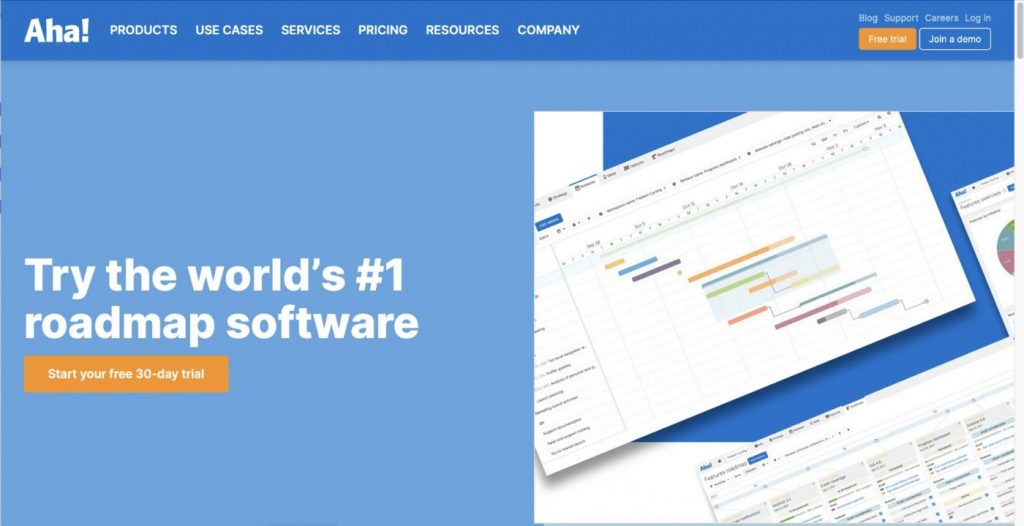
Aha! Software is a cloud-based product roadmap software that provides a complete solution for businesses to manage their product development process, from idea to launch. The software offers a comprehensive suite of tools to manage product roadmaps, track progress, and collaborate with stakeholders.
Aha! Software is designed to help businesses develop and deliver successful products by providing a centralized platform for managing all product-related activities. The software’s intuitive interface allows users to easily create product roadmaps, prioritize features, and track progress against goals and objectives.
With Aha!, businesses can also manage their product backlogs, track user feedback, and collaborate with team members and stakeholders. The software provides robust reporting and analytics capabilities, enabling businesses to gain valuable insights into their product development process and make data-driven decisions.
Aha! The software also offers customization options, enabling businesses to tailor the software to their specific needs and requirements. Additionally, the software is designed with security and compliance in mind, ensuring that businesses can trust their data is safe and secure.
Overall, Aha! Software is a comprehensive and powerful tool for businesses looking to streamline their product development process and deliver successful products.
Overview of Aha!
Aha! software is a web-based project management and product development tool that helps teams collaborate and deliver high-quality results. It provides a comprehensive set of features that enable users to plan, track, and manage their projects effectively.
One of the most significant benefits of Aha! software is its ability to create visual roadmaps that align product development with business goals and strategies. Users can create and customize roadmaps to track project progress, identify potential issues, and adjust priorities as needed.
Aha! also offers robust idea management capabilities, enabling users to capture and prioritize ideas from various sources. The software allows users to organize and manage ideas, track progress, and prioritize them based on their potential impact.
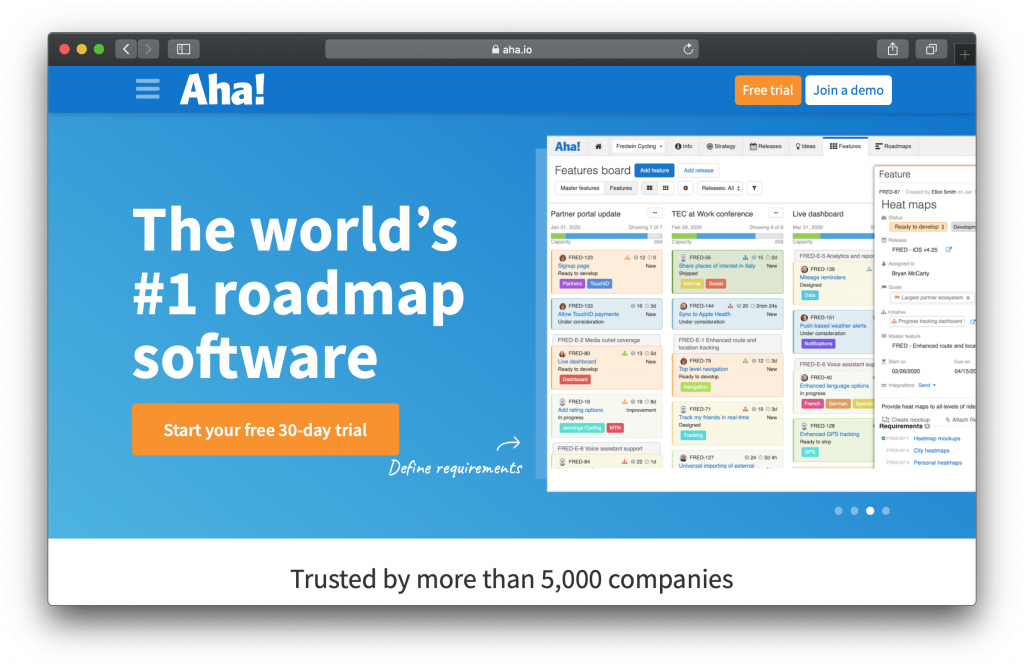
Agile project management is another critical feature of Aha! software. The tool supports methodologies such as Scrum and Kanban, allowing teams to manage sprints, backlogs, and user stories efficiently. This feature ensures that projects are delivered on time and within budget.
Product backlog management is another key feature of Aha! software. Users can organize and prioritize product features and requirements in a backlog, track progress, and adjust priorities as needed. This feature ensures that teams deliver the most valuable features to customers first.
Aha! also facilitates release management, enabling teams to plan and coordinate product releases effectively. Users can define release dates, milestones, and dependencies, ensuring that releases are delivered on time and meet customer expectations.
Overall, Aha! software is a powerful tool for project management and product development that enables teams to collaborate effectively and deliver high-quality results. Its comprehensive set of features and customization options make it a versatile tool for businesses of all sizes.
What is Aha!?
Aha! is a web-based software platform that provides project management and product development tools for businesses of all sizes. It enables teams to collaborate effectively and deliver high-quality results by providing a comprehensive set of features, customization options, and integration capabilities.
Aha! software includes a range of tools for idea management, agile project management, product backlog management, roadmap planning, release management, and collaboration. It supports methodologies such as Scrum and Kanban, allowing teams to manage sprints, backlogs, and user stories efficiently.
One of the most significant advantages of Aha! software is its ability to create visual roadmaps that align product development with business goals and strategies. Users can create and customize roadmaps to track project progress, identify potential issues, and adjust priorities as needed.
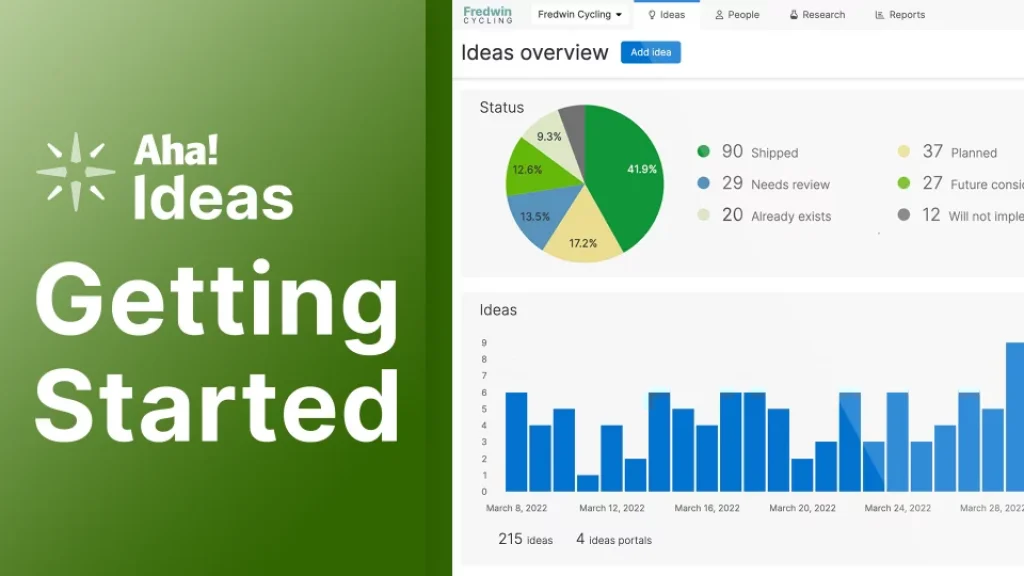
Aha! software also offers robust idea management capabilities, enabling users to capture and prioritize ideas from various sources, including team members, stakeholders, and customers. The software allows users to organize and manage ideas, track progress, and prioritize them based on their potential impact.
Aha! facilitates release management, enabling teams to plan and coordinate product releases effectively. Users can define release dates, milestones, and dependencies, ensuring that releases are delivered on time and meet customer expectations.
Overall, Aha! is a powerful tool for project management and product development that enables teams to collaborate effectively and deliver high-quality results. Its wide range of features, customization options, and integration capabilities make it a versatile tool for businesses of all sizes.
How does Aha! work?
Aha! works by providing a secure login process and personalized user dashboards to users. Here’s an overview of how Aha! works in terms of login and user dashboard:
- Login process: Users can access Aha! software by logging in to their accounts using their email address and password. The login process is secure, and users can set up two-factor authentication for added security.
- User dashboard: Once users have logged in to Aha!, they will see their personalized user dashboard. The dashboard provides an overview of their projects, tasks, and deadlines, as well as any updates or notifications they have received.
- Customization: Users can customize their dashboards to display the information and features they use most frequently. For example, they can add widgets to display project progress, upcoming deadlines, or recent activity.
- Navigation: Aha! software has a user-friendly interface that makes it easy to navigate between different features and tools. Users can access the various modules of the software, such as idea management, product backlog, roadmap planning, agile project management, and release management, from the main menu.
- Collaboration: Aha! software also enables users to collaborate with their team members by assigning tasks, commenting on work items, and sharing information. Users can set up workflows, manage approvals, and track progress, all from their user dashboard.
Overall, Aha! provides a user-friendly login process and a personalized dashboard that enables users to manage their projects and collaborate with their team members effectively.
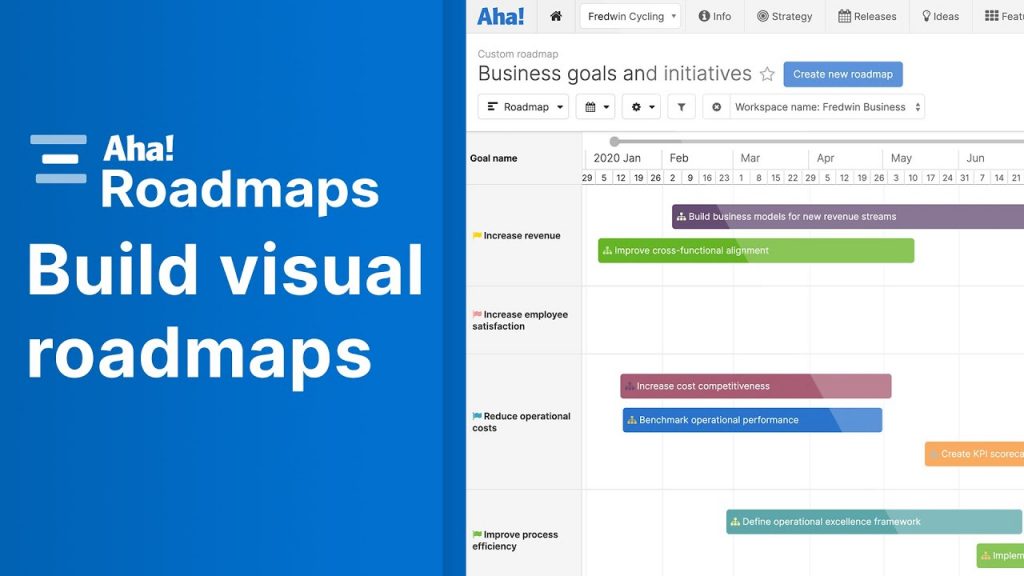
Aha!: Pros and Cons
Here are some pros and cons of Aha! software:
Pros:
- Comprehensive features: Aha! offers a comprehensive set of features for project management, idea management, agile project management, product backlog management, roadmap planning, and release management, making it a versatile tool for businesses of all sizes.
- Customization: Users can customize the software to suit their specific needs, including branding, workflows, fields, and data types.
- Integration: Aha! integrates with a wide range of other software tools, including popular project management tools, version control systems, and communication tools.
- Collaboration: Aha! enables teams to collaborate effectively by assigning tasks, sharing information, and tracking progress in real time.
- Visual roadmaps: Aha! software provides a powerful visual roadmap feature that enables users to create and customize roadmaps to track project progress, identify potential issues, and adjust priorities as needed.
Cons:
- Steep learning curve: Aha! software can be challenging to learn for new users, especially if they are not familiar with agile project management methodologies.
- Pricing: Aha! software can be expensive for small businesses or startups, as the pricing plans are based on the number of users and features.
- Limited mobile app: Aha! software has a limited mobile app, which may not provide all the features and functionality of the desktop version.
- Limited design customization: Although users can customize workflows, fields, and data types, the design customization options in Aha! software is limited.
- Limited analytics: Aha! software provides limited analytics and reporting features, which may not be sufficient for businesses with complex data analysis needs.
Ease of Use:
Aha! software is renowned for its ease of use, with a user-friendly interface and comprehensive help resources that make it easy for users to navigate and utilize its full range of features. The software is designed to be intuitive, with clear menus, icons, and labels that help users find what they need quickly. Moreover, Aha! software is highly customizable, allowing users to tailor it to their specific needs and preferences. Users can customize the workflows, fields, and data types to match their business processes, and they can also customize the interface to display the information and features they use most frequently. Aha! software also includes a range of automation features that help users save time and streamline their workflows. Users can automate tasks such as status updates, notifications, and approvals, which reduces the need for manual intervention and ensures that projects stay on track. Furthermore, Aha! software is designed to facilitate collaboration among team members, making it easy for users to work together and share information. Users can assign tasks, comment on work items, and share files, all from within the software. Overall, Aha! software is an easy-to-use, powerful tool for project management and product development that is suitable for businesses of all sizes.
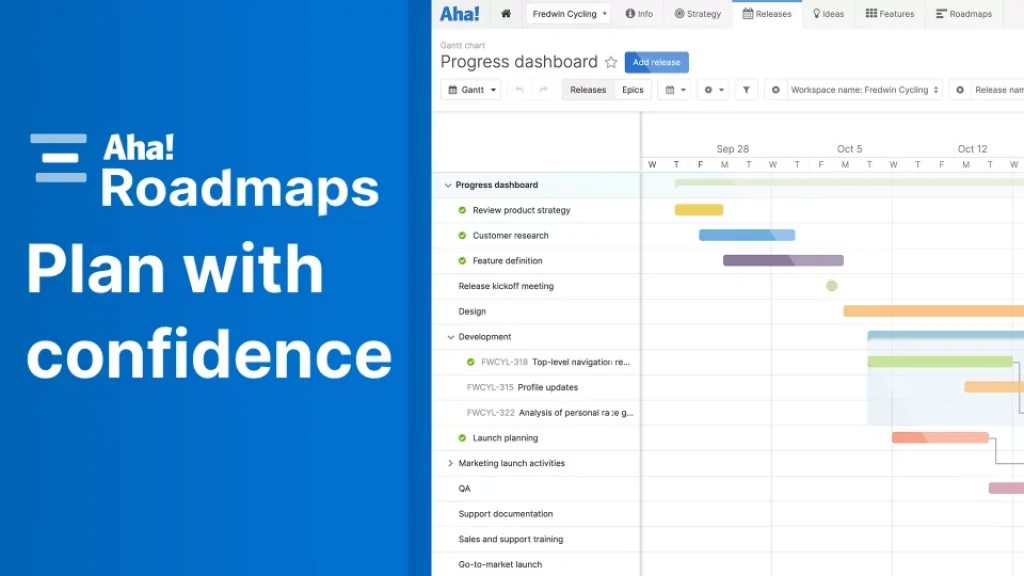
Features:
1. Roadmap planning:
Aha! software’s roadmap planning feature is a crucial aspect of its product management capabilities. It allows users to create multiple roadmaps that align with their overall product strategy and goals. This feature enables product managers to prioritize initiatives and track progress toward achieving milestones.
The visual roadmap feature is highly customizable, allowing users to create clear and detailed roadmaps that communicate the product vision and timeline to all stakeholders. The tool also allows for real-time collaboration between team members, ensuring that everyone is on the same page.
Aha! software’s roadmap planning feature also enables businesses to stay agile in a constantly changing market. The tool allows for easy adjustments to the roadmap, so businesses can quickly pivot their product strategy to meet new market conditions or customer needs.
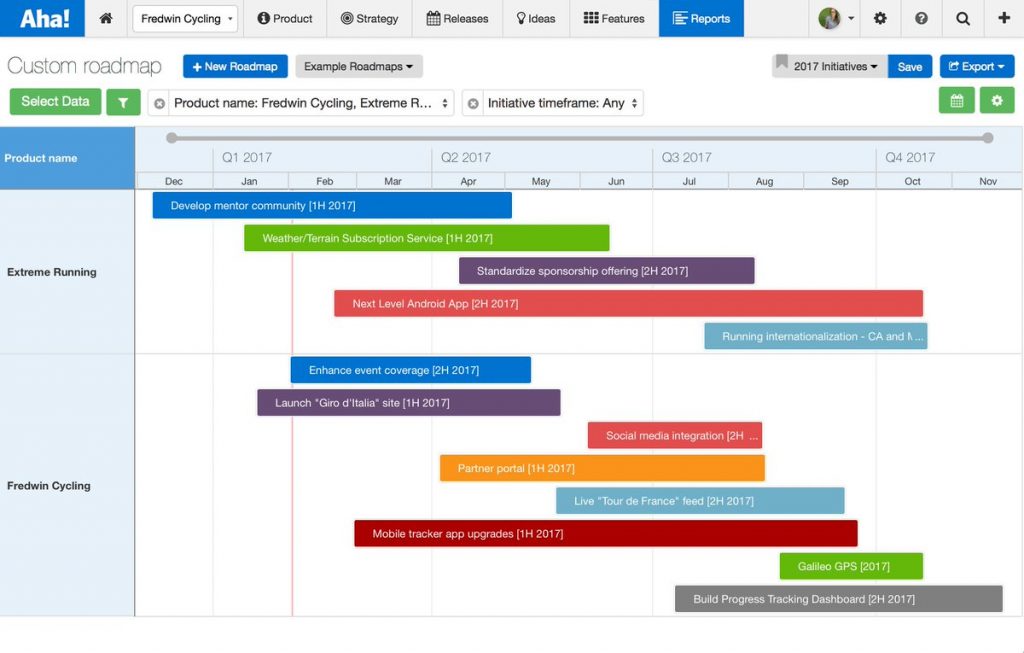
2. Idea management:
Aha! Software’s idea management feature is a valuable tool for businesses looking to capture, evaluate, and prioritize new ideas for product development. The feature allows users to create customizable idea portals where customers, employees, or other stakeholders can submit their ideas for consideration.
Once ideas are submitted, the idea management feature enables product managers to evaluate and prioritize them based on criteria such as feasibility, impact, and alignment with the product strategy. The tool also allows for collaboration between team members to further refine and develop the best ideas.
The idea management feature is highly customizable, allowing businesses to tailor it to their specific needs and workflows. It can also integrate with other Aha! software features such as the roadmap planning tool, enabling users to seamlessly incorporate promising ideas into their overall product strategy.
Overall, Aha! software’s idea management feature is a powerful tool that enables businesses to tap into the collective knowledge and creativity of their stakeholders. It allows for the efficient evaluation and prioritization of new ideas, leading to the development of better products and improved customer satisfaction.
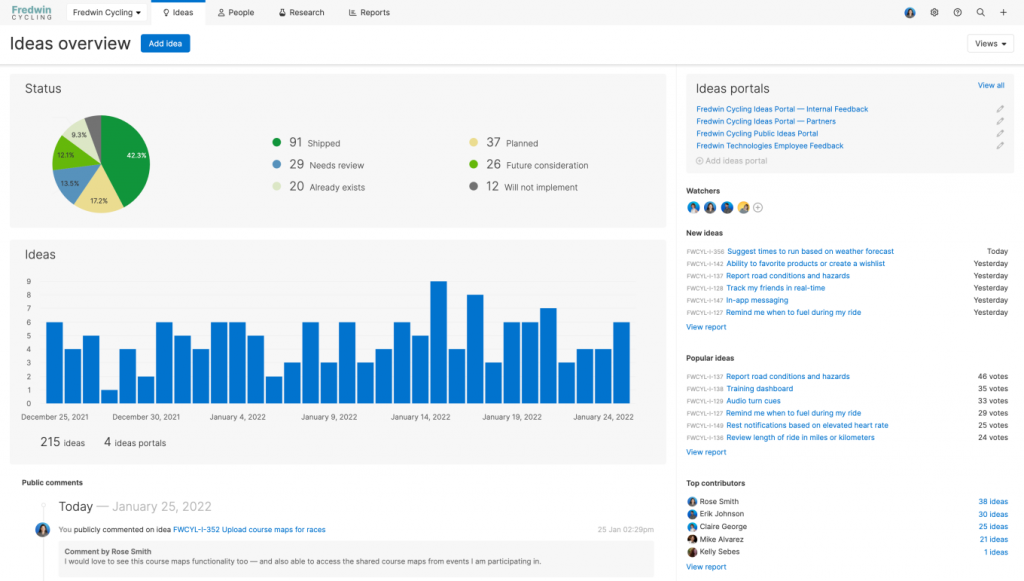
3. Agile project management:
Aha! Software’s Agile project management feature is a critical tool for businesses that use Agile methodologies in their software development processes. The feature provides a comprehensive set of tools to manage Agile projects, including sprint planning, backlog prioritization, and task management.
Aha! software’s Agile project management feature enables users to visualize their Agile projects with Kanban boards, sprint timelines, and other Agile-focused views. The tool also provides metrics and analytics to track progress, including velocity, burndown charts, and other key performance indicators.
The Agile project management feature also enables team members to collaborate in real time and keep everyone on the same page. With the ability to assign tasks and track progress, the tool ensures that all team members are aligned with the project goals and deadlines.
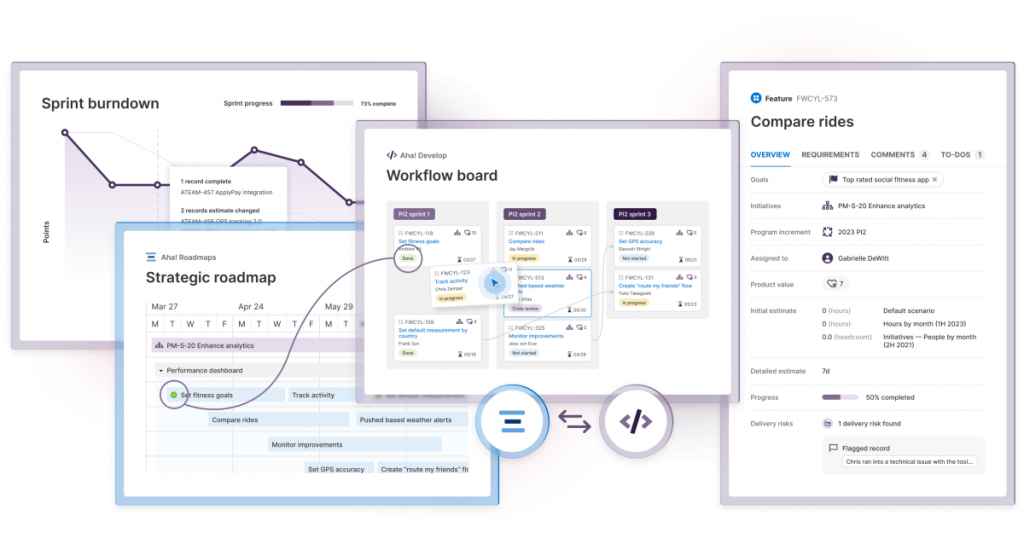
4. Product backlog management:
Aha! Software’s product backlog management feature is a valuable tool for businesses looking to prioritize and manage their product development backlog. The feature enables product managers to create, prioritize, and manage their product backlog in one central location.
The product backlog management feature allows product managers to easily drag and drop items in the backlog to prioritize them based on their importance to the overall product strategy. The tool also enables the creation of customizable fields to capture specific information about each backlog item, such as priority level, estimated time to complete, and customer value.
The product backlog management feature provides real-time visibility into the backlog, enabling teams to quickly adapt to changes in priorities or customer needs. The tool also integrates with other Aha! software features, such as the roadmap planning tool and idea management tool, to ensure that the backlog aligns with the overall product strategy.
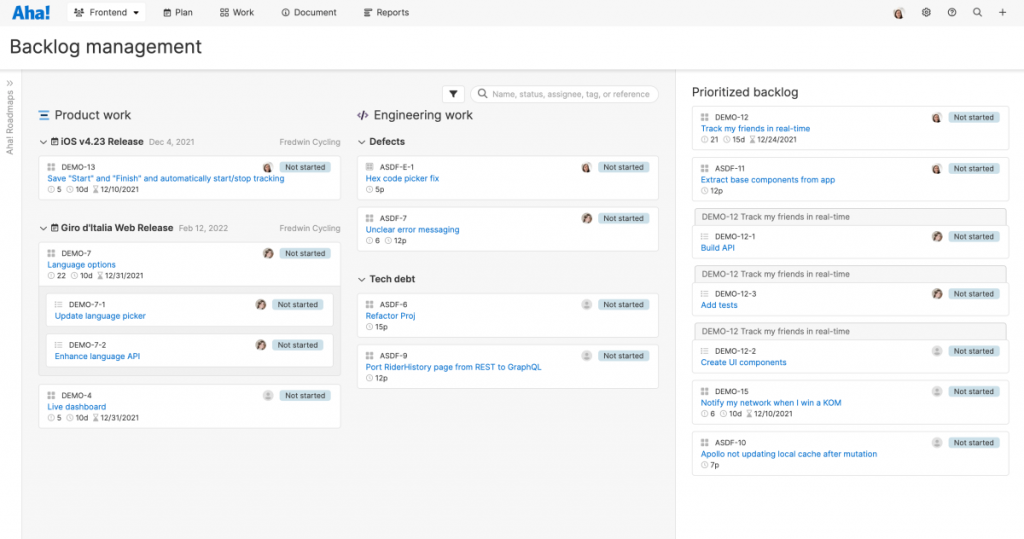
5. Release management:
Aha! software’s release management feature is a valuable tool for businesses looking to manage their product releases more effectively. The feature enables product managers to plan and track releases, including milestones, tasks, and dependencies, in one central location.
The release management feature allows product managers to create release plans that include information on the release timeline, features, and dependencies. The tool also enables teams to collaborate in real-time on release tasks, ensuring that everyone is aligned with the release goals and deadlines.
The release management feature provides visibility into the status of each release, enabling teams to quickly identify and resolve issues that may arise during the release process. The tool also integrates with other Aha! software features, such as the product backlog management tool and roadmap planning tool, to ensure that releases align with the overall product strategy.
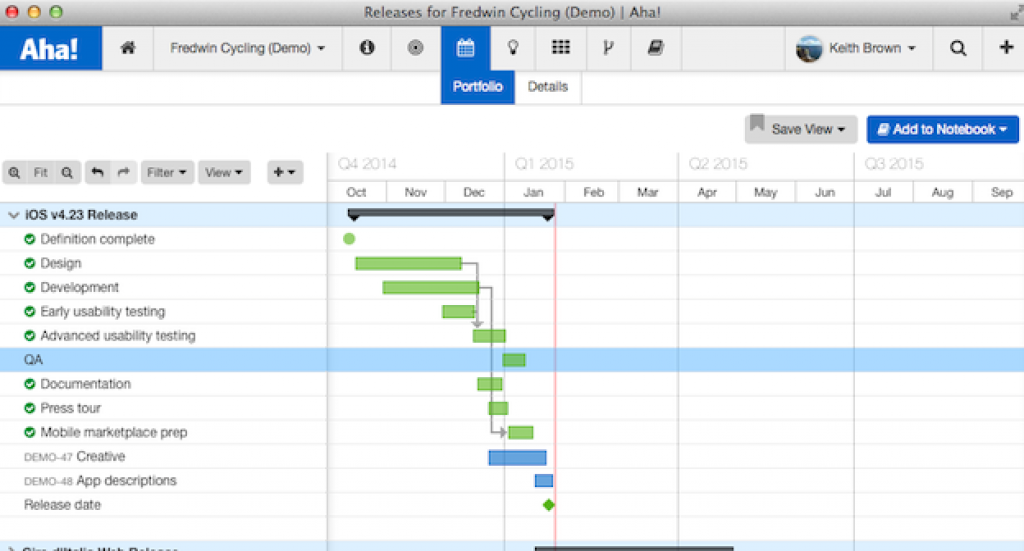
6. Collaboration tools:
Aha! software’s collaboration tools feature is a valuable tool for businesses looking to improve collaboration and communication between team members. The feature provides a central location where team members can collaborate on tasks, share ideas, and provide feedback, improving productivity and reducing the risk of miscommunication.
The collaboration tools feature allows team members to communicate in real time, including through commenting and tagging features, ensuring that everyone is on the same page. The tool also provides a central location for sharing documents and other files, ensuring that team members have access to the information they need to complete their tasks.
The collaboration tools feature provides a complete history of all changes and comments made by team members, enabling businesses to track progress and ensure that everyone is contributing to the project’s success. The tool also integrates with other Aha! software features, such as the roadmap planning tool and idea management tool, ensuring that collaboration aligns with the overall product strategy.

7. Reporting and analytics:
Aha! The software’s reporting and analytics feature is a valuable tool for businesses looking to measure the success of their product development efforts. The feature provides a range of reporting and analytics tools that enable businesses to track key performance indicators (KPIs), measure progress, and make data-driven decisions.
The reporting and analytics feature provides a range of pre-built reports that cover a wide range of metrics, such as progress against milestones, feature adoption, and team velocity. These reports enable businesses to quickly and easily identify areas of success and areas for improvement.
The feature also allows businesses to create custom reports, providing flexibility to measure and report on KPIs that are specific to their needs. The custom report builder enables businesses to select from a range of metrics and visualizations, ensuring that reports are tailored to the needs of the business.
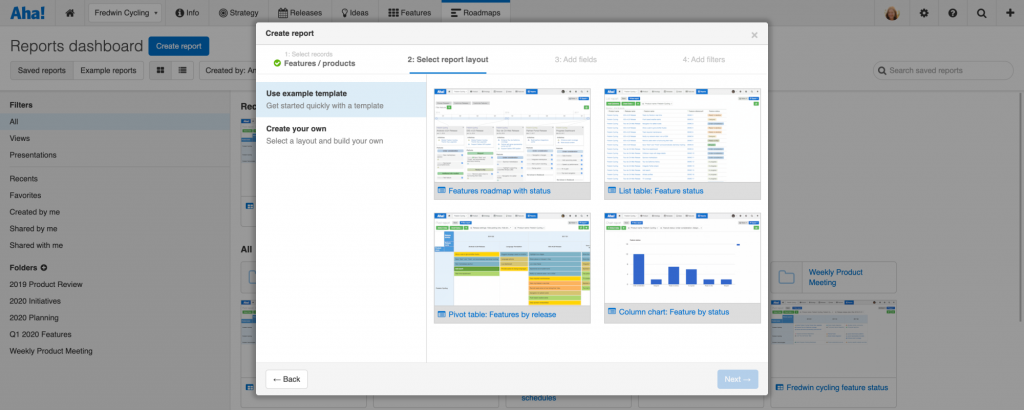
8. Security and compliance:
The security and compliance feature of Aha! software is a critical aspect of the platform that ensures the protection of confidential business data. The feature is designed to meet the highest security and compliance standards and regulations, including GDPR, SOC 2 Type II, HIPAA, and ISO 27001.
Aha! software’s security and compliance feature offers several key components, including multi-factor authentication, encryption of data in transit and at rest, and regular vulnerability assessments and penetration testing. Additionally, the platform offers role-based access controls, which ensure that only authorized users have access to specific information.
The feature also includes robust auditing capabilities, which enable businesses to track user activity and ensure that their data is secure. These capabilities are essential for businesses that operate in highly regulated industries or handle sensitive customer data.
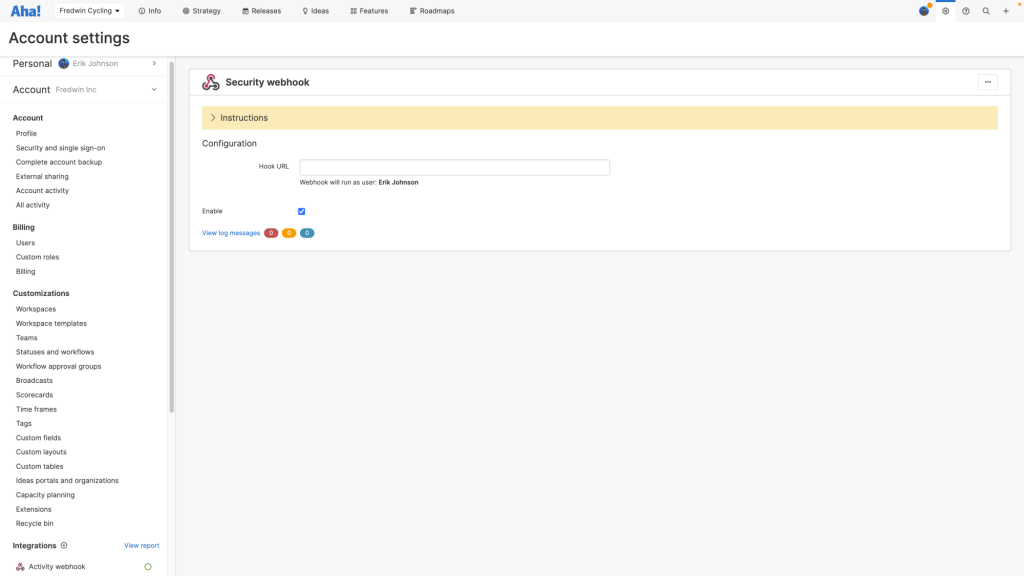
9. Customer feedback management:
The Customer Feedback Management feature of Aha! software allows businesses to gather and manage feedback from their customers. The feature is designed to help businesses understand their customers’ needs and make informed decisions about product development and feature prioritization.
The feature offers several key components, including a customer feedback portal, automated feedback collection, and integration with customer service tools. The feedback portal provides a dedicated space for customers to submit their feedback, which businesses can then analyze and prioritize based on various criteria such as user vote, priority level, or severity.
Automated feedback collection allows businesses to collect feedback from various sources, such as email, social media, and website forms. This feature saves time and reduces the chances of feedback being missed or lost.
The integration with customer service tools ensures that businesses can manage feedback alongside customer inquiries and support requests. This integration streamlines communication with customers and helps businesses understand how feedback relates to support and service requests.
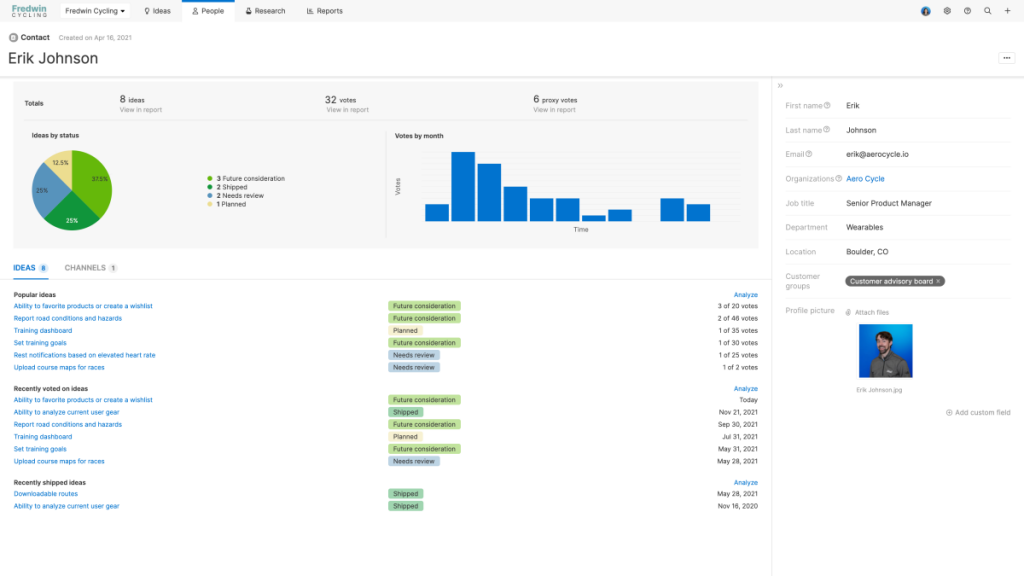
10. Strategy alignment:
Aha! software’s Strategy Alignment feature is a powerful tool that helps businesses align their strategy with their goals and initiatives. This feature provides a structured approach to defining and tracking strategic objectives, ensuring that all stakeholders are working towards the same goals.
With this feature, businesses can create strategic themes and objectives, map them to initiatives, and track progress toward achieving them. This approach provides transparency and ensures that everyone is aware of the business’s overall strategy and how it is being executed.
The Strategy Alignment feature also enables businesses to cascade objectives down to individual team members, ensuring that everyone is aligned and working towards the same goals. This feature also provides visibility into how individual objectives contribute to the larger strategic goals, helping team members understand the impact of their work.
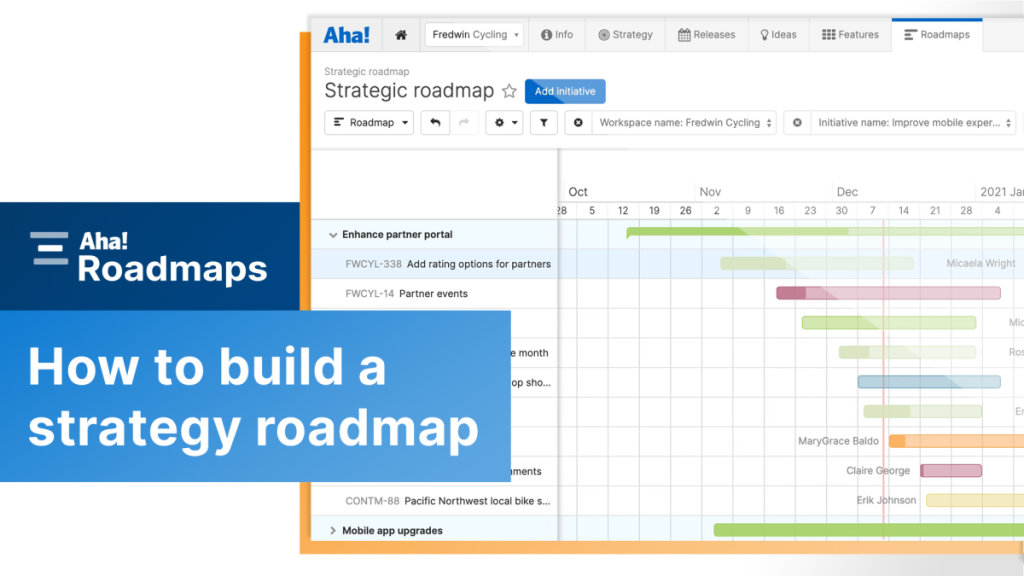
11. Customization options:
Aha! software’s Customization Options feature provides businesses with a high degree of flexibility in tailoring the platform to their specific needs. With this feature, businesses can customize various aspects of the software, including fields, workflows, terminology, and themes.
The customization options for fields allow businesses to create their fields and organize them in a way that makes sense for their operations. This feature also enables businesses to customize the values that appear in dropdown menus, making it easier to standardize data input across teams.
The workflow customization feature allows businesses to create custom workflows that match their existing processes. This feature also provides flexibility in adding and removing stages and defining the rules that govern each stage.
The terminology customization feature enables businesses to use their industry-specific terminology within the platform. This feature helps reduce confusion and ensures that everyone within the organization is on the same page.
Finally, the theme customization feature allows businesses to customize the look and feel of the platform to match their branding guidelines. This feature makes it easy for businesses to create a unified experience for their teams and stakeholders.
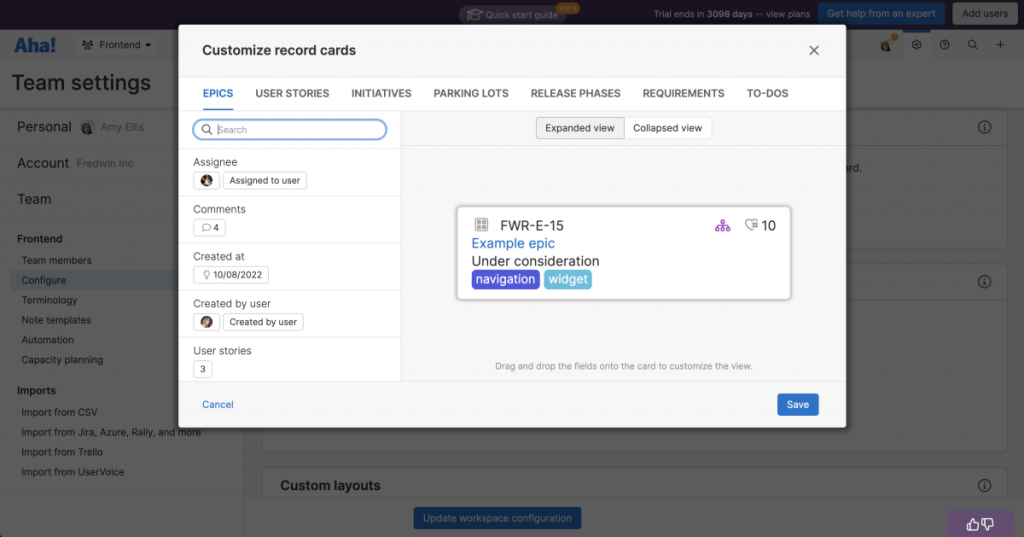
Integrations:
Aha! software offers a wide range of third-party integrations that allow users to connect with other tools and services they use for project management, product development, and more. Here are some of the key third-party integrations that are available with Aha! software:
- Development tools: Aha! software integrates with a variety of development tools, including Jira, GitHub, Trello, and Microsoft Azure DevOps. This allows users to connect their development work with their product roadmap and other strategic planning.
- Communication and collaboration tools: Aha! software integrates with communication and collaboration tools like Slack, Microsoft Teams, and HipChat. This enables team members to stay up-to-date on project updates and collaborate seamlessly within their preferred communication platform.
- Customer support tools: Aha! software integrates with customer support tools like Zendesk, Intercom, and Salesforce Service Cloud. This enables users to track customer feedback and requests and incorporate them into their product roadmap.
- Analytics tools: Aha! software integrates with analytics tools like Google Analytics, Mixpanel, and Segment. This allows users to track user behavior and data and use it to inform product decisions.
- File sharing tools: Aha! the software integrates with file-sharing tools like Box and Google Drive, enabling team members to share files and collaborate on documents from within Aha! software.
These third-party integrations extend the capabilities of Aha! software and enable users to connect with the tools and services they already use. By integrating with these tools, Aha! software enhances collaboration, streamlines workflows, and makes it easier for users to manage their product development and project management activities.
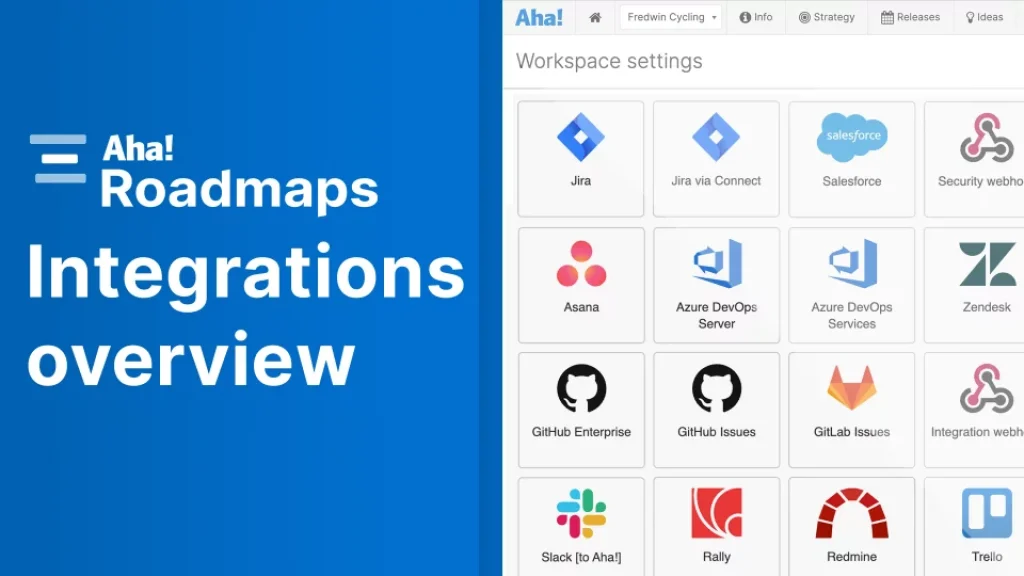
Pricing:
Aha! software offers a range of pricing plans to suit different business needs and budgets. Here is an overview of the pricing options available:
- Startup: This plan is designed for small teams and costs $59 per user per month when billed annually. It includes features such as strategy creation and management, road mapping, idea management, and basic reporting.
- Business: This plan is suitable for growing businesses and costs $99 per user per month when billed annually. It includes all the features of the Startup plan plus additional reporting options, custom fields and workflows, integrations, and advanced security features.
- Enterprise: This plan is designed for large organizations and includes advanced features such as custom roles and permissions, single sign-on, and API access. The Enterprise plan pricing is available upon request and includes personalized support and implementation services.
- Free trial: Aha! software also offers a free 30-day trial that includes all the features of the Business plan.
It is important to note that the pricing of Aha! software is based on a per-user basis, which means that the cost increases as the number of users increases. Additionally, all plans include unlimited products and features, which means that users can create and manage as many products and projects as they need.
Overall, Aha! software offers flexible pricing plans that cater to businesses of different sizes and needs, and its transparent pricing structure makes it easy for users to calculate their costs and budget accordingly.
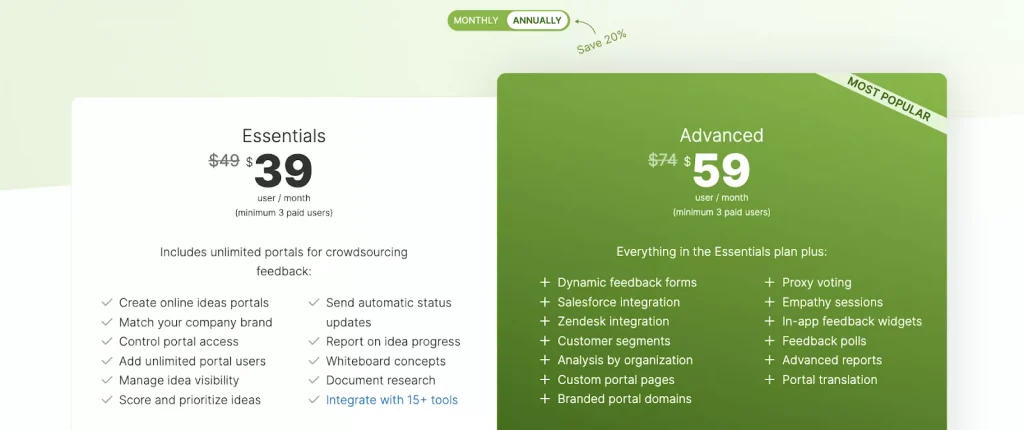
Alternatives of Aha!
There are several alternatives to Aha! software that offers similar features for project management and product development. Here are three main alternatives and a comparison of their features:
Trello: Trello is a popular project management tool that uses boards and cards to organize tasks and projects. It offers a simple, intuitive interface that is easy to use and customizable. However, Trello is more limited than Aha! software in terms of strategic planning and road mapping features. While it is suitable for basic project management and collaboration, it may not be ideal for more complex product development activities.
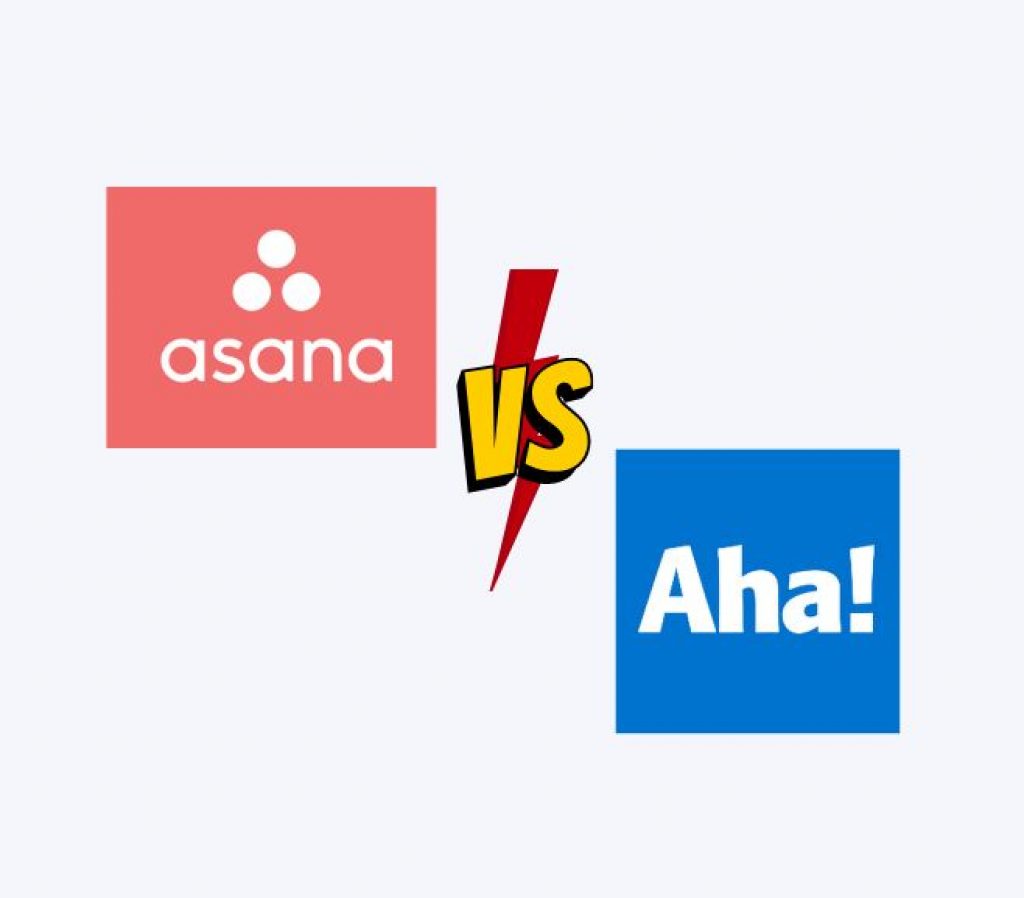
Asana: Asana is another popular project management tool that offers a range of features for task and project organization, team collaboration, and reporting. It is more robust than Trello in terms of strategic planning and reporting features but may be more complex to use. However, Asana may not offer the same level of product development and roadmapping features as Aha! software, making it more suitable for project management and task tracking.
Productboard: Productboard is a product management tool that is designed to help teams gather customer feedback, prioritize product ideas, and plan product roadmaps. It offers a range of features for customer research, idea management, and prioritization. However, it may be less flexible than Aha! software in terms of customization options and integrations with other tools.
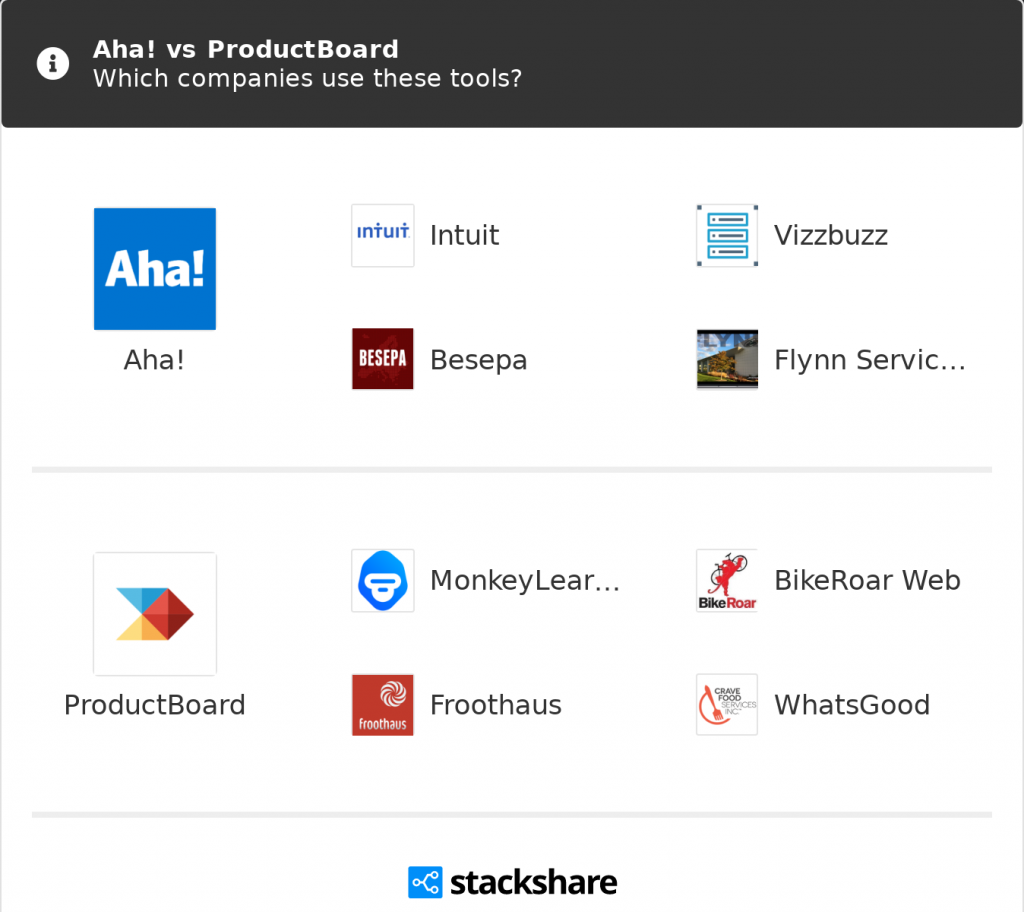
In summary, while Trello and Asana are suitable for basic project management and team collaboration, they may not offer the same level of strategic planning and roadmapping features as Aha! software. Productboard, on the other hand, is more focused on product management and customer feedback, but may not offer the same level of customization and integrations as Aha! software. Ultimately, the choice of which tool to use will depend on the specific needs and priorities of each business.
Aha! Customer Support:
Aha! software prides itself on offering excellent customer support to its users. The company provides multiple resources to help users get started and make the most of the software, including a comprehensive online help center, user guides, and video tutorials.
For users who need more personalized assistance, Aha! software offers customer support through multiple channels. Users can submit support requests through a ticketing system, and the company typically responds within a few hours. Additionally, Aha! software offers phone support during business hours, as well as live chat support for users with urgent issues.
Aha! software also provides personalized support for customers on its higher-tier plans, including the Enterprise plan. These customers have access to a dedicated customer success manager who can help with onboarding, product training, and ongoing support.
Overall, Aha! software’s customer support is highly regarded by users, with many praising the prompt and helpful responses from the support team. The comprehensive online help center and resources, combined with personalized support for higher-tier plans, make Aha! software is a strong choice for businesses looking for reliable and responsive customer support.
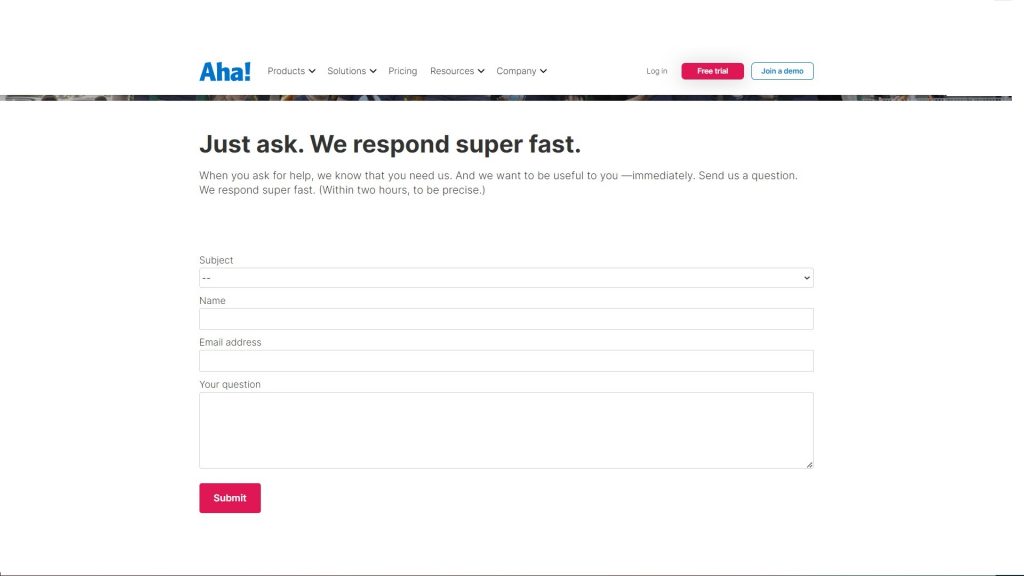
Final Thoughts:
In conclusion, Aha! software is a powerful tool for product management and strategic planning. Its extensive feature set, including road mapping, prioritization, and reporting tools, makes it a top choice for businesses looking to develop and launch products more efficiently. While the pricing may be steep for smaller businesses, the customizable plans and pricing options make Aha! software accessible to a range of businesses.
Additionally, Aha! software’s customer support is highly regarded by users, with multiple resources available to help users get started and make the most of the software. Users can submit support requests through a ticketing system, access online resources, and even receive personalized support through a dedicated customer success manager.
While there are several alternatives to Aha! software, including Trello, Asana, and Productboard, Aha! software stands out for its focus on product development and strategic planning. The extensive features, customizable plans, and excellent customer support make it a top choice for businesses looking to streamline their product development processes and stay competitive in today’s market.
Overall, Aha! software is a powerful and reliable tool for businesses looking to develop and launch products more efficiently. With its comprehensive features, flexible pricing options, and excellent customer support, it is a solid choice for businesses of all sizes looking to stay ahead in today’s competitive market.
Frequently Asked Questions:
Q1. What is Aha! software?
Ans: Aha! software is a web-based product management and strategic planning tool.
Q2. What features does Aha! software offer?
Ans: Aha! software offers features such as road mapping, prioritization, reporting, and idea management.
Q3. How much does Aha! software cost?
Ans: Aha! software pricing starts at $59/user/month, with customizable plans available.
Q4. Does Aha! software offer a free trial?
Ans: Yes, Aha! software offers a 30-day free trial.
Q5. What integrations does Aha! software support?
Ans: Aha! software supports integrations with tools such as JIRA, Salesforce, and Slack.
Q6. What industries does Aha! software cater to?
Ans: Aha! software is used by businesses across various industries, including technology, healthcare, and finance.
Q7. What kind of customer support does Aha! software provide?
Ans: Aha! software provides customer support through a ticketing system, phone support, and live chat. Higher-tier plans also include a dedicated customer success manager.
Q8. Can multiple users collaborate on Aha! software?
Ans: Yes, Aha! software supports collaboration between multiple users.
Q9. Is Aha! software customizable?
Ans: Yes, Aha! software offers customizable plans to meet the specific needs of businesses.
Q10. What kind of security measures does Aha! software have in place?
Ans: Aha! software uses encryption and other security measures to protect user data.

